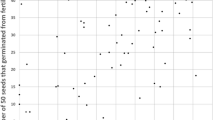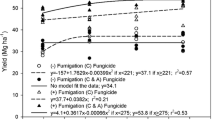Conclusions
Trials during 1943 and 1944 of three commercial root hormones applied as dust to seed potatoes resulted in no increases in yield. Rootone and transplantone were compared in 1943, rootone and tubertone in 1944. Rootone retarded emergence, reduced the stand and appeared to be toxic to sprout growth. Es-Min-E1, a commercial mixture of trace-elements, applied at rates of 50 and 100 pounds to the acre in the row and separate from the regular fertilizer application, showed no benefits. The conclusion is that this relatively infertile highly acid, gravelly loam soil was not lacking in these minor elements.
A comparison of cut seed dusted with ground limestone, cured seed, greensprouted seed, and freshly cut untreated seed resulted in no significant difference in stand of plants. Although the greensprouted seed emerged first, grew fastest early in the season and gave the highest total yield, the results were not statistically better than those from the dusted, cured and untreated seed. Profitable results from greensprouting, curing or dusting might be expected under less favorable seedbed conditions or in seasons less favorable to prolonged plant growth.
Similar content being viewed by others
Author information
Authors and Affiliations
Additional information
Published as Paper No. 272. Department of Vegetable Crops, Cornell University, Ithaca, N.Y.
Rights and permissions
About this article
Cite this article
Hardenburg, E.V. Comparative studies of several potato seed treatments. American Potato Journal 22, 1–5 (1945). https://doi.org/10.1007/BF02868821
Issue Date:
DOI: https://doi.org/10.1007/BF02868821




